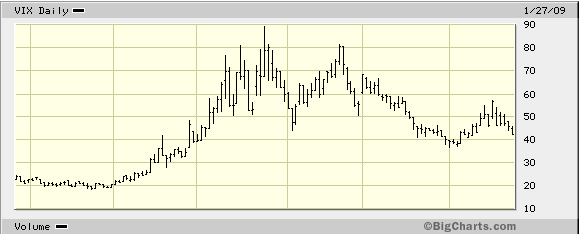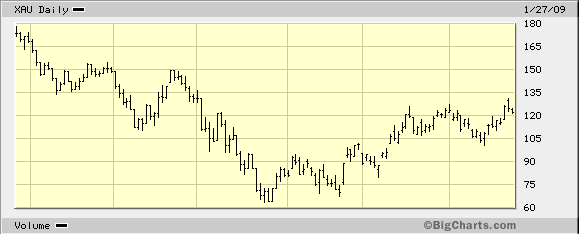Red sky at night, sailor’s delight
Red sky at morn, sailors be warned.
-
Technical musings
In recent trading days we have seen various indicators reach levels that, had they occurred together during another set of social and economic conditions, would have warranted an aggressive bullish stance. As they have arisen during the greatest depression and stock market collapse in any living person’s memory (geezers included), traders should perceive an elevated risk of a swift revival of market panic.
If we are going to start back towards the November lows sometime in the first half of the year, the next few days are as good a time as any. Optimism, or at least the abatement of fear, peaked around the first week of the year. At that time, most bulls and bears alike seemed to be counting on a BIG bounce, and that consensus view was manifested as as the top of a relatively anemic corrective rally.
Stocks then sold off solidly for two weeks, as the volatility index (VIX) ran from 38 to 58, a level that until last fall hadn’t been seen since a brief moment in 1987. Even 38 would have been indicated panic conditions until the world was turned upside down. In this environment, it indicates calm. Here is a six-month view:
-
The bond market also indicated relief this month, as a rally for the history books finally broke when the 30-year Treasury bond yielded just 2.5%. Yesterday it yielded 3.41%, another level that until a few weeks ago had not been seen for decades (in this case, six of them). In this crash, 3.41% means complacency and even optimism. 30-year bond yield, 6-month view, courtesy of Yahoo! Finance:
-
One more indication that the correction is exhausting itself has been the revival of animal spirits in commodities stocks, a popular ‘risk’ sector. XAU, the Philadelpia Gold and Silver Index, more than doubled from its crash lows. I am guessing that these stocks made their post-crash top yesterday, coinciding with bullion’s three-month high, because both are solidly overbought. This top in risk preference has occurred alongside the last few days’ rebound in the broader stocks indexes. Risk assets are the last to participate in rallies and the hardest hit in crashes.
-
Now, with the exception of gold stocks and bullion, none of the above markets are particularly overextended at the moment. Bonds today made either a solid correction of their sell-off (corrective itself), or started a fresh leg up. The broad stock indexes are not overbought, which is the easiest time to identify shorting opportunities, so tread lightly if you are thinking about that route. I have been heavily long-term short for 18 months now, so if I am wrong on these little twists and turns it doesn’t bother me.
I would not be surprised by a loss of several percent in the Dow by next week, but neither am I counting on it. This market has been choppy and full of contradictions since December. Stocks went up with Treasury bonds last month, and this month the dollar has rallied with gold. Go figure. In cases like this, it is best to not have too strong an opinion on the market’s short-term moves. In recent days I have even covered several long-standing short positions as stocks such as Microsoft, Harley Davidson, Burlington Northern, and Union Pacific have pushed to new lows.
Keep in mind that we still could re-enact the November 1929 to April 1930 post-crash rally, in which the Dow rose 48% before the mood turned back down and stocks fell another 80% in two years. See A massive rally is straight out of the 1929 playbook.
Anyone sense a change in the air?
For the bigger picture, all you have to do is glance at a newspaper. From a non-technical perspective, the trend is clear: things are getting worse, much worse. Earnings will continue to surprise to the downside, to an extent that few can imagine. Firings and bankruptcies are just getting rolling. As the illusion of prosperity wilts away, we are going to discover that our productive capacity has been hollowed out by the distortions of the credit bubble and regulations, and that a drastically reduced standard of living awaits. Needless to say, stock prices will be proportionate.



